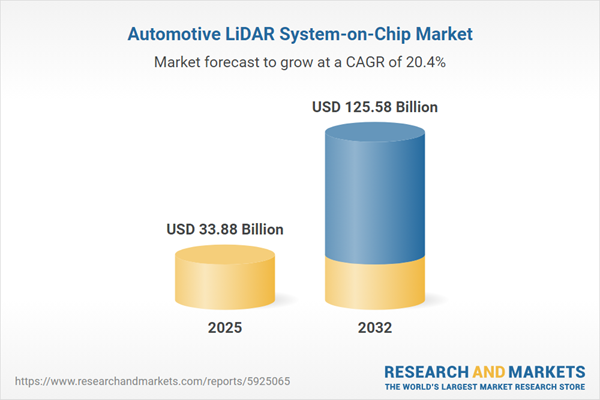Speak directly to the analyst to clarify any post sales queries you may have.
The Automotive LiDAR System-on-Chip market is rapidly evolving, offering industry leaders new opportunities for innovation, cost efficiency, and strategic competitive positioning as next-generation sensing technologies reshape the future of mobility.
Market Snapshot: Growth Trajectory of the Automotive LiDAR System-on-Chip Market
The Automotive LiDAR System-on-Chip market grew from USD 28.35 billion in 2024 to USD 33.88 billion in 2025. It is expected to continue growing at a CAGR of 20.44%, reaching USD 125.58 billion by 2032. Demand is driven by automotive OEMs accelerating advanced driver assistance, autonomy, and safety features, bolstered by solid-state solutions and a maturing supplier ecosystem.
Scope & Segmentation: Comprehensive Analysis of Technology, Application, and Regional Dynamics
This report provides a detailed evaluation of all major segments shaping the automotive LiDAR System-on-Chip market:
- LiDAR Technology: Mechanical LiDAR; Solid State LiDAR (Flash LiDAR, MEMS Based, Optical Phased Array)
- Propulsion Type: Electric Vehicles; Internal Combustion Engine Vehicles
- Range Type: Medium-to-Long Range LiDAR; Short-to-Medium Range LiDAR
- Perception Type: 2D & 3D; 4D
- Application: Advanced Driver Assistance Systems (Adaptive Cruise Control, Forward Collision Warning, Lane Departure Warning, Pedestrian & Object Detection); Automated Parking Assistance; Autonomous Driving Systems; Collision Avoidance Systems; Surround View / Environmental Mapping (360 Degree Perception, HD Mapping)
- Vehicle Type: Commercial Vehicles (Heavy Commercial Vehicles, Light Commercial Vehicles); Passenger Vehicles
- Regional Coverage: Americas (United States, Canada, Mexico, Brazil, Argentina, Chile, Colombia, Peru); Europe, Middle East & Africa (United Kingdom, Germany, France, Russia, Italy, Spain, Netherlands, Sweden, Poland, Switzerland, United Arab Emirates, Saudi Arabia, Qatar, Turkey, Israel, South Africa, Nigeria, Egypt, Kenya); Asia-Pacific (China, India, Japan, Australia, South Korea, Indonesia, Thailand, Malaysia, Singapore, Taiwan)
- Key Companies Analyzed: Aeva Inc., indie Semiconductor, Inc., Cepton, Inc., Infineon Technologies AG, LeddarTech Holdings Inc., Mobileye Technologies Limited, Qualcomm Technologies, Inc., Renesas Electronics Corporation, RoboSense, Scantinel Photonics GmbH, SiLC Technologies, Inc., STMicroelectronics N.V., Synopsys, Inc., Texas Instruments Incorporated, The Charles Stark Draper Laboratory, Inc, Voyant Photonics, Inc
Key Takeaways: Strategic Insights for Senior Decision-Makers
- Integrated LiDAR System-on-Chip architectures combine high-precision sensing with embedded processing, enabling real-time situational awareness critical to advanced vehicle automation.
- Solid-state solutions, including MEMS and Optical Phased Array designs, are supplanting traditional mechanical LiDAR due to enhanced reliability and miniaturized sensor profiles.
- Market adoption trends differ by vehicle propulsion, with electric vehicles emphasizing efficiency and modular integration, while internal combustion models focus on cost-effective scalability.
- The rise of on-chip edge computing streamlines perception algorithms, reducing the reliance on central vehicle controllers and accelerating decision cycles for safety features.
- Geo-specific regulatory standards, particularly in Western Europe and the Asia-Pacific, are prompting rapid adaptation in product portfolios, ecosystem collaborations, and deployment strategies.
- Mergers, acquisitions, and collaborative R&D initiatives across suppliers and semiconductor specialists are intensifying, reflecting the industry's move toward consolidated innovation pipelines.
Tariff Impact: Navigating Global Supply Chain Realignment
The 2025 United States tariffs on imported automotive LiDAR components have prompted market realignment. Leading suppliers are shifting to onshore or nearshore production to control tariff exposure, boost supply chain resilience, and reduce logistical risks. Tier 1 players are diversifying sourcing partnerships, involving alternative fabricators in Europe and Asia-Pacific. These shifts necessitate additional capital investments, enhanced risk management, and closer alignment with new compliance frameworks. Organizations that proactively adapt their procurement and manufacturing approaches are best positioned to maintain innovation velocity and market responsiveness.
Methodology & Data Sources: Automotive LiDAR System-on-Chip Market
This analysis is built on primary interviews with executives and engineers from sensor manufacturing and integration, supplemented by peer-reviewed academic sources, patent reviews, and public corporate filings. Cross-validation and multi-source triangulation were employed to secure data accuracy and minimize bias. Extensive segmentation and regional profiling underpin the findings.
Why This Report Matters
- Supports investment prioritization and roadmap optimization with actionable insights specific to technology trajectories and regional requirements.
- Enables leadership teams to align product, procurement, and partnership strategies with evolving regulatory, tariff, and competitive realities.
- Equips senior decision-makers with detailed segmentation and competitor analysis to strengthen positioning in a fast-growing segment of next-generation vehicle innovation.
Conclusion
The Automotive LiDAR System-on-Chip market presents a strategic inflection point for industry leaders driving innovation and operational agility. This report provides the clarity and depth necessary to navigate technical, regulatory, and regional complexities. Leverage these insights to sustain growth and achieve long-term leadership in the evolving landscape of automotive sensing.
Additional Product Information:
- Purchase of this report includes 1 year online access with quarterly updates.
- This report can be updated on request. Please contact our Customer Experience team using the Ask a Question widget on our website.
Table of Contents
3. Executive Summary
4. Market Overview
7. Cumulative Impact of Artificial Intelligence 2025
Companies Mentioned
The companies profiled in this Automotive LiDAR System-on-Chip market report include:- Aeva Inc.
- indie Semiconductor, Inc.
- Cepton, Inc.
- Infineon Technologies AG
- LeddarTech Holdings Inc.
- Mobileye Technologies Limited
- Qualcomm Technologies, Inc.
- Renesas Electronics Corporation
- RoboSense
- Scantinel Photonics GmbH
- Scantinel Photonics GmbH
- SiLC Technologies, Inc.
- STMicroelectronics N.V.
- Synopsys, Inc.
- Texas Instruments Incorporated
- The Charles Stark Draper Laboratory, Inc
- Voyant Photonics, Inc
Table Information
| Report Attribute | Details |
|---|---|
| No. of Pages | 187 |
| Published | November 2025 |
| Forecast Period | 2025 - 2032 |
| Estimated Market Value ( USD | $ 33.88 Billion |
| Forecasted Market Value ( USD | $ 125.58 Billion |
| Compound Annual Growth Rate | 20.4% |
| Regions Covered | Global |
| No. of Companies Mentioned | 18 |








